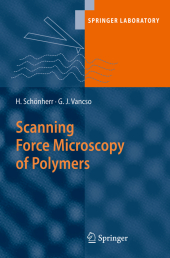 Neuerscheinungen 2016Stand: 2020-02-01 |
Schnellsuche
ISBN/Stichwort/Autor
|
Herderstraße 10
10625 Berlin
Tel.: 030 315 714 16
Fax 030 315 714 14
info@buchspektrum.de |

Holger Schönherr, G. J. Vancso
(Beteiligte)
Scanning Force Microscopy of Polymers
Softcover reprint of the original 1st ed. 2010. 2016. xiv, 248 S. 40 Tabellen. 235 mm
Verlag/Jahr: SPRINGER, BERLIN; SPRINGER BERLIN HEIDELBERG 2016
ISBN: 3-662-51749-3 (3662517493)
Neue ISBN: 978-3-662-51749-9 (9783662517499)
Preis und Lieferzeit: Bitte klicken
This lab manual introduces the reader to scanning force microscopy of polymers based on a practice-oriented approach. It aims to ´teach´ the reader to pick up the knowledge and skills necessary to obtain reliable results within the shortest possible time.
Scope of the Book Synthetic and natural polymers exhibit a complex structural and morphological hierarchy on multiple length scales [1], which determines their performance. Thus, research aiming at visualizing structure and morphology using a multitude of microscopy techniques has received considerable attention since the early days of polymer science and technology. Various well-developed techniques such as optical microscopy and different forms of electron microscopy (Scanning Electron Micr- copy, SEM; Transmission Electron Microscopy, TEM; Environmental Scanning Electron Microscopy, ESEM) allow one to view polymeric structure at different levels of magni?cation. These classical techniques, and their applications to po- mers, are well documented in the literature [2, 3]. The invention of Scanning Tunneling Microscopy (STM) inspired the devel- ment of Atomic Force Microscopy (AFM) and other forms of scanning proximity microscopes in the late 1980s [4, 5]. AFM, unlike STM, can be used to image n- conducting specimens such as polymers. In addition, AFM imaging is feasible in liquids, which has several advantages. Using liquid imaging cells the forces between specimen and AFM probe are drastically reduced, thus sample damage is prevented. In addition, the use of water as imaging medium opened up new applications aiming at imaging, characterizing, and analyzing biologically important systems.
From the reviews:
"Atomic force microscopy (AFM) can be used to image polymer surfaces over a broad range from several nanometers to more than 100 micrometer scan sizes. ... one of the most engaging and practical books ever on the topic of AFMs. It provides the reader with insightful methods for imaging polymer surfaces at elevated temperatures and in other situations. ... would be suitable for both industrial researchers and academic personnel working in the laboratory. ... Anyone who uses an AFM will find this book extremely useful." (IEEE Electrical Insulation Magazine, Vol. 27 (4), July/August, 2011)


